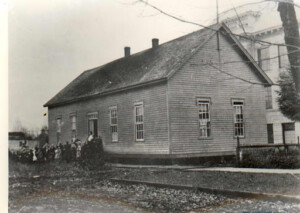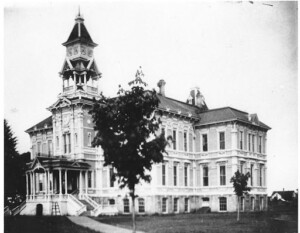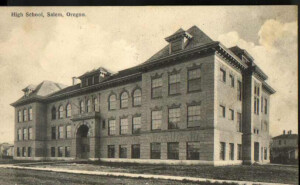A General History of Education in Salem
Education came to the Oregon Territory and to Salem with the arrival of the early missionaries. Between the years of 1834-1840, Jason Lee and David Leslie, along with other missionaries and their families worked to establish several Indian missions in the Willamette Valley. Jason Lee worked with the Indians near Salem to set up an Indian training school. His work was not entirely successful, but he did not give up. He decided to resettle in Salem and continue his work there. He and the other missionaries saw opportunities for the future settlement of the Oregon Territory, and Salem. In 1842, these men met together in Salem to organize and establish the Oregon Institute. This school was the fulfillment of their desire to create a school to educate their own children and provide the opportunity for an education to other Oregon families that were settling in Salem. These men knew that education was the key to a stable, responsible population that would lead and guide the Oregon Territory into future statehood.
The First School
The first school house in Salem was a log cabin at the southwest corner of Marion and Commercial streets. It was built in 1850 and was mainly supported by families paying tuition to send their children to school. Some other money for the school came from county funds and rate bills. By January 1855, Salem school district 24J was officially organized by William P. Pugh, the county superintendent.
Central School

1905c., The last day of old Central School. New Salem High School in background. Marion Street, between High and Church Streets., WHC Collections 0083.006.0017.002
As the town of Salem grew, so did the need for more schools. In 1857, Central School was built near High Street between Center and Marion Streets, the present site of Meier & Frank. Ten year old T. T. Geer, a future Governor of Oregon from 1899 to 1903, attended Central School in 1861.
By 1859 there were 227 school age children in the district, but there is no record of how many children actually attended school. By 1865 the number of children in the district had grown to 632 with 200 students in attendance at Central School. More students meant more schools. In 1866, the district levied a 5 mill tax to build two new school. One was built in north Salem and the second school was constructed in south Salem. South School, as it was named, was originally located at Fir and Myers Streets, but it was moved to South Commercial Street in 1892. The school building was later used in turn as a cider mill, machine shop and as the W. A. Barkus Feed Mill.
Between the years of 1866 to 1869 “Little” Central School and East Salem School were built. “Little” Central School was near the original Central School with fifteen non-Anglo students taught by Mrs. R. Mallory.
East Salem School

East School, 12th & Center Sts. Built 1887, remodeled and renamed Washington School in 1915. Razed in 1949., WHC Collections 2007.001.1032
East Salem School was originally located at 12th and Center Streets which now is the downtown Safeway site. East Salem School stood on this site until about 1886-1887. The building was then moved to the southeast corner of Liberty and Court Streets to make way for the new East School. East School was completed in 1887 at the 12th and Center Street site and was built to hold 600 students in up to ten grades using twelve classrooms. Eventually East School became known as Washington School in 1915. The original 1869 East Salem School building was then used to house both the Capital Journal newspaper and the Vidette, the state Democratic newspaper between the years 1888 to 1890.
In 1871, the school board officially proposed a 3 mill school levy. It was voted on and passed by the citizens of Salem, and with that action, taxes were collected and set aside for the use of Salem schools.
Elementary Schools Grow
Minimum elementary school grade levels had been established by 1875 along with a standard school year of 40 weeks. The school year started in September with three terms of 16, 14, and 12 weeks each along with a 2 week vacation. There was also the beginnings of a strong interest in developing higher grades beyond the elementary level. There was no high school at this time, but there was a growing desire and need to give students the opportunity for further education. In the approximately 25 years from 1875 to the turn of the century in 1900 saw Salem unofficially add higher grades with added subjects. This was the future basis for an official high school curriculum.
First High School

1909, Salem High School, North elevation facing Marion street. Between High and Church streets. Brick building. Postmark March 1909 Salem. Addressed to Remoh F. Evans Salem, Oregon C/o Mrs. Hattie Frost Corn Mill and 15th Streets. Message: Dear Remoh, How are you getting along with the measles? Hope you take care of yourself and not try to study any until you get well. Try to keep your mind occupied trying to see what that man gained on the horse trade. Tell Clara to do the same. WHC Collections 2003.001.0014
By 1901, Salem officially voted in a ninth grade, the first year of high school. By the years of 1902-1903, there were 90 students just in the 9th and 10th grades at East School with no juniors or seniors. These freshmen and sophomore high school students were enthusiastic about high school and were already participating in a wide variety of high school activities. They included sports, drama clubs, debating groups, social societies, and literary groups. The first high school newspaper, The Clarion, was published in 1904.
There was still no officially established four year high school in Salem, but in 1904 an election was held and the people of Salem passed a measure that officially added a high school class each year. With this vote, the residents of Salem recognized the need to continue to offer a high school education to Salem students and to provide a permanent four year high school. The following year, in 1905, the school board authorized the first four year high school to be built in Salem.
The future Salem High School was built on the present Meier & Frank site facing southeast from Marion Street. Central School also sat on this site until Salem High School was completed. Central School was then moved to the corner of Commercial and Center Streets in 1906.
Salem High School was a modern building for its time, using the latest technology and products in its construction. It was made of Newberg pressed brick and held a state of the art heating and venting system which recirculated air every six minutes. The high school had 16 large classrooms, a library, and laboratories. In the basement were restrooms, a furnace room and a bicycle room. The third floor held an unfinished gym, assembly hall and stage. These rooms were eventually finished, with the gym and assembly hall completed in Italian style décor. A year later Salem High School was dedicated in ceremonies held on the evening of January 1, 1906.
Superintendent J. M. Powers spoke at the dedication ceremonies, and his remarks reflected the pride Salem held for its new high school. By 1936, when a new high school building was completed, the original Salem High School had become administrative offices.
North and South High School
The new Salem High School was built at 14th and D Streets. By the time South Salem High School was built in 1954, Salem High School was renamed. It became North Salem High School, and it still retains this name. Over the years it has gone through many renovations and improvements and is still located at 14th and D Streets. Two famous alumni from North Salem High School are former Senator Mark Hatfield, and Matt Moritz, who was drafted by the Kansas City Royals baseball team in 1993.
Through the many intervening years, the number of Salem schools has steadily grown. In 1871 there were five schools in Salem. Willamette University had been established and had an enrollment of 258 students. The Academy of the Sacred Heart was educating young women and accepted all students from every denomination. The annual Salem city census of 1877 documented 1,529 children of school age. Out that number, 680 students were enrolled in public schools. The rest of the students were attending Willamette University, Academy of the Sacred Heart or J. W. Sellwood private school, or not attending school at all. In 1898 the Salem city directory shows fourteen colleges and private schools in Salem, and five public schools.
1920 to 2000
By 1921 Salem continued to have over a dozen colleges and private schools. The number of public schools jumped to twelve. That included one high school, three junior high schools, and eight elementary schools. The 1932 Salem city directory shows eleven schools in the district. This included one high school, two junior high schools, and three parochial schools. There was a total of 5,536 students enrolled in the district, and 286 teachers. By 1978, Salem had five high schools and thirty-eight elementary schools. In the year 2000, the Salem school district had thirty-nine elementary schools, nine middle schools, and five high schools, along with two alternative school and one charter school. By the fall of 2002, West Salem is scheduled to open a new high school with a maximum enrollment of 1600 students. The total enrollment in the Salem-Keizer school district is about 34,000 students in 2000.
Researched and written by Susan Gibby
This article originally appeared on the original Salem Online History site and has not been updated since 2006.







Leave A Comment